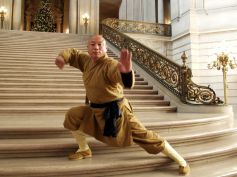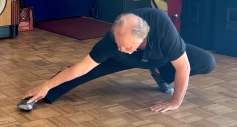
Practice notes
A review of Newsletter #1 practice tips:
During your Qi Gong practice (and during meditation) it is suggested you do the following for maximum benefit:
Tongue Placement
Your jaw should be either very softly shut and relaxed or slightly open. The tip of your tongue should be touching the upper palate of your mouth just behind the front teeth. The
optimal position of your tongue is almost but not quite touching the front teeth - (however do not worry if it is touching slightly and on this note "worrying" is worse than being slightly less
than perfect - you will get better over time - so do not worry).
The reason behind this important practice tip:
We all have an energy circuit that encircles our torso from front to back - it is know here in the West as the Microcosmic Orbit. This circuit consists of two meridians,
the Du Meridian and the Ren Meridian.
The Du Meridian starts at the perineum (the area between the anus and the scrotum in males and between the anus and vulva in females) and goes up the back, over the head
and down to the upper palate of the mouth.
The Ren Meridian goes from the tongue down through the throat, chest and abdomen to the perineum.
By touching the tongue to the upper palate as suggested, these two important meridian’s (also known as extraordinary vessels) are connected.
- Breath & Breathing
Some of you from Eastern meditation traditions including Zen and Yoga are familiar with "belly
breathing", where you imagine you are breathing into your belly area. In Qi Gong you imagine you are breathing into the Lower Dan Tien (LDT). The LDT is an energy center located
below your navel about three finger widths down and two finger widths in. Over time you will no longer need to imagine this center because you will definitely feel it.
The LDT stores Qi (vitality/life force).
The literal meaning of "dan tien" also spelled: dantien, dan t'ian, or tan t'ien is - cinnabar or red field and it is commonly referred to in the West as "energy center", also "elixir field" and
"the sea of qi".
Their are three Dan Tiens: the lower (LDT), the middle (MDT) and the upper (UDT). All of them are energetic storage mechanisms.
- The Lower Dan Tien (LDT) is also know as the "golden stove" and it is where in the practice of Qi Gong the refining and purifying essence (jing) is transformed into vitality (qi). Qi is stored in the LDT.
- The Middle Dan Tien (MDT) is located at the level of the heart. This center or cauldron is where Qi/Vitality is refined into Shen/Spirit. It is associated with storing Shen (spirit) and is related to respiration and the health of the internal organs including the thymus gland.
- The Upper Dan Tien (UDT) is located at the forehead in the area also known as the third eye between the eyebrows and it is associated with the pineal gland. This center is where Shen (spirit) is refined into Wu Wei (emptiness).
The Lower Dan
Tien is sometimes referred to simply as the "dan tien" and it is often described to be "like the root of the tree of life", it is considered the center of gravity of the human body and is
the seat of one's internal energy (Qi).
When you breath-in, imagine that you are breathing into the LDT first and then allowing the breath to fill up in the higher areas. As you breath out, breath out in reverse from the top down. Do not
lock the breath: when you breath-in as you stop do not lock off the air passage. When you breath-out do not lock off the air passage upon exhale.
As you progress you will increase your lung capacities, increasing the amount of time you can hold an inhale or an exhale and - it is very important to note - you will also learn timing. Do not worry
about matching the teacher "perfectly", you will need to move your breath at times when the teacher does not and this is expected. Simply try to push yourself within a comfort zone that you are
comfortable with - (this is your practice).
Regarding timing as noted above: you will find that at times you are moving along in a relatively simple exercise and you are breathing shallow with no problem. In the next movement you may be doing
something that is for you quite difficult and you do not have enough air. During simple movements remember to take in plenty of air, get the oxygen into your blood stream and when you come to the
more difficult moves you will have more reserve oxygen.
Also, on some of the exercises where you twist, breath-in at the start of the movement and not slowly as you twist. This is
for two reasons: properly done, you will already have a full breath in the first 1/4 of the twisting movement so that as you twist the inner air is both compressed and pushing outward (stretching you
from the inside). Also, if you do not take in the breath at the very beginning of the movement, the twisting will greatly reduce the amount of breath you can take in and so it will greatly
affect the time you can hold/carry your breath.
When you are in a movement where you are doing simple expansion and contractions - such as when you have your hands extended one toward the sky and the other to the ground - notice what you do
as you inhale when they come together and as you exhale as they are pushed apart - it is common not to inhale as much and as long as when you exhale - this leaves you short of breath. Slow down a bit
on the inhale and really fill yourself comfortably and keep it for as long as you keep your exhale. In other words if your exhale is 15 seconds, your inhale should be 15 seconds.
On a sort of side note to breathing is the issue of food and drink prior to practice:
Food and drink prior to practice can definitely effect how well you are able to practice. A small amount of each should be no problem and may help your overall energy and awareness. A large amount of
either will make a number of movements difficult to do and will very clearly effect your ability to breath deeply and hold positions comfortably. Also note that some foods even in small amounts will
cause bloating - so avoid these foods entirely prior to practice.
Shoes - foot wear - clothing
Foot wear should have flat soles - (not a raised heel).
Qi Gong will help your posture and your entire physical and subtle energetic systems - it is best to practice with your feet in a flat natural position - this will effect the results of the entire
course of exercises you are doing. It is better to practice in socks than in a raised heel shoe of any type.
Some rubber soles are very tacky/sticky and this can also be troublesome for the knees, ankles and certain movements in particular - and this can be a big problem on certain clean surfaces where the
shoes practically stick in place - (such as on a freshly waxed gym floor or clean linoleum). Bare feet can also be sticky on these floors so socks are a better option or a flat sole that is not too
tacky/sticky.
Clothing should be comfortable and not restricting in the waist. It should not be distracting - meaning that it
should not be a shirt that moves up on you and needs constant adjustment or a pair of pants that are too tight or ones that are threatening to fall to your knees. It is also preferable to have
natural fabrics - the subtle energetic systems are effected by fabric.
Regarding worrying
Do not worry if you "are doing it right". With more and more practice is will become obvious where you need to work and you will be constantly improving. If you cannot bend over without bending
your knees for example, then bend your knees - and do not be concerned about this at all! If you
need to take an extra breath or two or three - no not be concerned about this at all! What is far
more important than "perfection" is your inner calm and attentiveness to the energies as they unfold into your awareness.
Regarding "warm up"
Here in the West we often look upon "warm up" exercises as not really being necessary or important. For many sports particularly non-professional sports this is somewhat true if we ease into
them.
This is not actually true for Qi Gong. During the "warm up" exercises we are not just moving our muscles and stretching - we are also "rooting" with our feet and legs ("grounding" is a term used in
the West) - we are bringing the participation of earth energies into our space.
In the "warm up" we are also moving our arms and bringing the participation of "heavenly" energies ("cosmic energy" is a term used in the West) into our space.
Other "warm up" exercises integrate these energies and very much effect our balance - our ability to balance ourselves - such as standing on one foot.
Finally, the "warm up" exercises help us to settle into stillness and awareness within, prior to the more specific movements. This time is also when the teacher has designated as the starting point
and it is traditionally regarded as the time to start and not later. In some areas of the world - if you are going to be late your are not welcome to attend - this is not the case here but it would
be helpful for you and it shows your respect to others and to the teacher so please to try to be on time or early.
(If in fact you must be late - and even if you must always be late - please come late and do not at all worry about it. But if you are constantly late and you could be constantly on time, then
please make the effort to adjust your timing and arrive early or on time).
"Warm up" exercises in Qi Gong are really much more than just a bit of movement before the "real stuff" - they are part of the "real stuff".
The earliest forms of Qi Gong were taught as high spiritual practice and for the greater part of their existence (some 4,000 years) a great portion of a teaching was secretive and passed on only by
oral transmission from master to student. The Qi Gong you are studying here carries within it the potential for very high spiritual practice if this is of interest to you. Grand Master Yao carries
the lineage of a teaching that encompasses not only great health benefits and the proper rooting for martial arts and energetic power, it is also a very high teaching for those pursuing
self-cultivation and enlightenment.
We want you to know that Shaolin Master Qi Gong is absolutely dedicated to remaining and maintaining a genuine
teaching that is not "westernized" out of its base and away from its truth.


